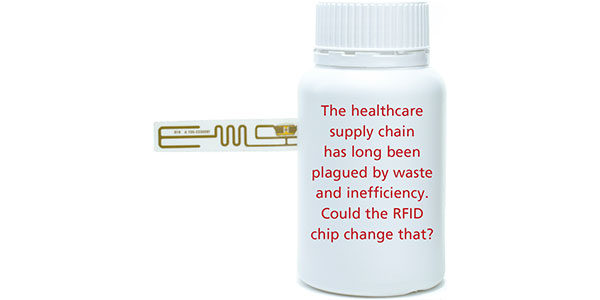Rx for a better healthcare supply chain

Radio-frequency identification (RFID) technology has spread through the logistics field in fits and starts.
One of the biggest "starts" came in 2003, when retailing giant Wal-Mart Stores Inc. mandated that its top suppliers prepare to tag shipments of pallets and cases with the tiny electronic chips. Although many suppliers rushed to comply, the dream of achieving inventory accuracy and labor savings soon ran into the harsh reality of high equipment costs and unreliable technology.
A decade later, RFID began to gain new proponents, as fashion industry and electronics retailers started to tag high-value items. By that time, many of the technology's kinks had been worked out, and tag prices had dropped to the point where RFID had become a viable solution to tracking costly inventory and discouraging shoplifters.
Now, RFID is gaining traction in another new sector, as an increasing number of businesses in the healthcare supply chain embrace the technology. They see RFID as a potential solution to a wide range of challenges, from tracking expensive devices to reducing unnecessary inventory stockpiles.
Most consumer goods retailers find that RFID tags—and the readers and networks that collect their data—are still too expensive to be used for tracking individual items like a jug of milk or a stapler. But the sheer size of the healthcare industry and the high value of items such as pharmaceuticals and medical devices have convinced many medical users that they'll likely see a quick return on any investment in the technology.
The sector could also use RFID to keep up with rapidly changing market conditions such as increased demand for services triggered by aging baby boomers, downward price pressure exerted by the Affordable Care Act, and track and trace capabilities mandated by the 2013 Drug Supply Chain Security Act.
RFID tags can help practitioners meet these market demands and save money, delivering a return on investment (ROI) by eliminating waste, increasing visibility, improving inventory tracking, and boosting regulatory compliance.
TAKING AIM AT WASTEMany hospitals keep excess equipment in their stockrooms in order to ensure they can instantly provide any medical supply that a patient might need. Even with overnight delivery, there is no time to order a missing item when medical emergencies strike. That means waste reduction is a prime target for saving money.
"Today, we are faced with a healthcare supply chain with an unsustainable amount of waste," says Jean-Claude Saghbini, chief technology officer and vice president of inventory management solutions at Cardinal Health Inc. in Dublin, Ohio. Hospitals and medical device manufacturers throw one in five products in the garbage because the inventory has expired or is mismatched with patients' needs, he says.
"The root cause is the lack of visibility; the data is not there and it is not shared," Saghbini says. "By the time you scan a can of soup at the grocery register, everyone's doing analytics on the purchase: the manufacturer, the retailer, the consumer products producer. But there is much less data collected when you implant a $20,000 pacemaker."
"SMART SHELVES" BOOST VISIBILITYOne answer to the visibility problem may come in the form of RFID-enabled "smart shelves" that use embedded RFID scanners to automatically track high-value inventory like implantable stents, knees, heart valves, and pacemakers.
Each smart shelf has a power cord and an Internet connection, so it scans the items dozens of times per day, then sends that information to an inventory management platform that can be accessed by hospitals, manufacturers, and distributors. Most systems also run these scans every time an item is stocked or removed, recording details such as the lot number, serial number, universal product number (UPN), purchase order, expiration date, the time it arrived, and how long it's been sitting in inventory.
Compared with existing stock-keeping methods like handheld bar-code scanners or manual paper checklists, RFID scans collect more data and share it more broadly with other systems. The approach allows data to quickly flow between separate software platforms such as a device maker's manufacturing execution system, a healthcare network's materials management system, a hospital's electronic medical records platform, and a supplier's warehouse management system (WMS), Saghbini says.
NO DRUG LEFT BEHIND?Another way that RFID can pay off in healthcare applications is by helping businesses adhere to strict product safety and security protocols, says Josh Cannon, director of global healthcare strategy at Atlanta-based UPS Inc.
For example, to comply with provisions of the Drug Supply Chain Security Act aimed at maintaining product integrity, discouraging theft, and preventing counterfeiting, logistics professionals in the pharma supply chain must implement rigorous systems for tracking and tracing their shipments. The precision of RFID tracking can help them meet the Food and Drug Administration (FDA) requirement that they be able to pinpoint the location of any drug throughout the supply chain and drill down to the individual package level.
The benefits of ensuring the safe, swift delivery of medical products to hospitals go beyond the savings achieved through streamlining the supply chain, however. It also helps improve patients' experiences.
"Leveraging this technology to streamline processes such as order placement for orthopedic-device surgeries and having visibility over inventory in distribution centers close to hospitals makes the supply chain an important component to patient care," Cannon says.
The use of RFID could make the supply chain more efficient by allowing suppliers to track pharmaceuticals and medical devices, fill orders quickly, support cost-savings initiatives, improve inventory control, and reduce errors, he says.
"Effective inventory management is critical within the healthcare supply chain, and RFID technology is a powerful tool for tracking, gaining visibility over inventory, and overall building out a more optimized, integrated warehousing and distribution network," Cannon says.
THE ROAD AHEADDespite the benefits of streamlining the supply chain for high-value healthcare products, the widespread adoption of RFID is still hampered by the technology's cost. RFID providers have made progress on driving down costs in recent years, but the solution is still too expensive to tag everyday items like bandages when you add up the price of the chips, software, hardware, and integration with existing software platforms.
"Within healthcare, RFID has found practical use for protecting high-value products such as implantable medical devices," Cannon says. If improvements in manufacturing and technology continue to make RFID cheaper, the technology could spread much farther throughout the healthcare sector.
One such avenue might arise from the confluence of RFID technology with an unexpected platform—smartphones. An increasing number of smartphones use wireless technology called near field communications (NFC) to transmit payment data when waved near a target or to exchange information when bumped against another phone.
Since NFC uses the same wireless specification as high-frequency RFID tags, that means millions of Americans will soon be enabled with RFID readers in their pockets, Cardinal Health's Saghbini says. This could have sweeping implications for home health care, he adds.
For instance, patients with RFID-scanning smartphones could monitor their own home medical care by recording the pharmaceutical products and medical devices they use each day and sending the data to their physicians. In turn, that could empower senior citizens to live more years in their own homes before moving to assisted-living facilities.
Medical providers in many corners of the healthcare industry are finding that the latest generation of RFID tracking and data-analysis technology can provide a reliable return on investment. From manufacturers to warehouses and from hospitals to homes, RFID adds visibility to the healthcare supply chain and could become an important tool in empowering the sector to meet the demands of practicing modern medicine.
Related Articles

Copyright ©2024. All Rights ReservedDesign, CMS, Hosting & Web Development :: ePublishing